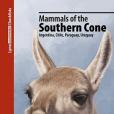《Mammals of the Southern Cone》是Lynx Edicions出版的圖書。
基本介紹
- 外文名:Mammals of the Southern Cone
- 出版時間:2020年2月
- 出版社:Lynx Edicions
- 頁數:160 頁
- ISBN:9788416728268
- 裝幀:Paperback
- 叢書:Lynx Illustrated Checklists Collection
- 售價:EUR 22.00
內容簡介
This illustrated checklist covers The Southern Cone of South America and its associated islands (Argentinian and Chilean Austral Zone islands, Falklands (Malvinas), Desventuradas Islands and Juan Fernández Archipelago), a region rich in habitat diversity and harboring a corresponding richness of mammalian life. Although not a traditional Field Guide, this book will equip both r...(展開全部) This illustrated checklist covers The Southern Cone of South America and its associated islands (Argentinian and Chilean Austral Zone islands, Falklands (Malvinas), Desventuradas Islands and Juan Fernández Archipelago), a region rich in habitat diversity and harboring a corresponding richness of mammalian life. Although not a traditional Field Guide, this book will equip both residents and visitors to the region with an easy-to-use resource to quickly learn all the species of mammals known to occupy the area. It covers 486 species of mammals, including 17 introduced species with established wild populations (American Beaver, American Mink, Blackbuck, Black-capped Squirrel Monkey, Brown Rat, Chital, Common Fallow Deer, Common Muskrat, Eurasian Wild Pig, European Hare, European Rabbit, House Mouse, Mouflon, Pacific Rat, Pallas’s Squirrel, Roof Rat, and Western Red Deer) and three domesticated ones (Alpaca, Llama, and Water Buffalo). Every species is illustrated, and each is accompanied with a distribution map showing where it occurs in the area. With respect to the domesticated species, Alpaca and Llama have full treatment because of their regional importance, while the Water Buffalo has been included because there are also feral populations that are hunted. The Southern Cone land area (including south-eastern Brazil) represents 26% of the total land area of South America. It includes a wide array of habitats between the semiarid lowlands of the Chaco and the tropical rainforests of the Atlantic Forest region in the north to the Patagonian cold steppes in the s

